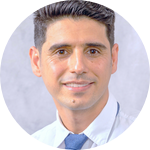About This Project
We investigate technoeconomics and aspirational CA targets for CA-enhanced KOH/K2CO2 DAC processes with electrochemical sorbent regeneration. We use i) state-of-the-art modelling with bespoke electrolyser models integrated in process modelling software and ii) true prospective technoeconomic analysis methods to answer robustly how well CA needs to perform to bring this DAC technology to <$300/tCO2, striving for $100/tCO2, by 2050.
Ask the Scientists
Join The DiscussionWhat is the context of this research?
The US government target scale & cost for air carbon dioxide removal (CDR) is 1-10 Gt CO2/yr at $100/tCO2 by 2050, recent work shows a more plausible Gt-scale cost range is $100-600/tCO2 net removed (1). Direct air capture (DAC) is easily verifiable and durable, but is currently estimated to cost ~$350-3000/tCO2 net removed (1). The primary cost factors are the CapEx and the energy required to drive large temperature or pH swings to regenerate CO2 from the capture material (1). Liquid DAC’s high cost and energy requirements are driven by a trade-off between the rate of CO2 absorption and the CO2 regeneration energy: CO2 capture absorbents with high absorption rate can reduce cost by reducing the air contactor size, but typically have high CO2 regeneration energy, and vice versa (2)
What is the significance of this project?
Carbonic anhydrase (CA) enzymes catalyze CO2 exchange. CA can enable fast CO2 absorption in capture absorbents with low CO2 regeneration energy, resolving the tradeoff discussed above (3). CA could enable efficient DAC with smaller temperature or pH swings if it can be stabilized in DAC processes, which may include high pH, temperature, or ionic strength.
Protein engineering (PE) and novel CA discovery through systematic screens of natural variants could produce stable CA for DAC. However, no designs for CA-optimized DAC are proposed, so it is unclear what conditions CA must be engineered to tolerate. Design-oriented techno-economic analysis (TEA) could enable CA-enhanced DAC development by identifying optimal process conditions and providing clear targets for PE.
What are the goals of the project?
We investigate technoeconomics and aspirational CA targets for CA-enhanced KOH/K2CO3 DAC processes with electrochemical sorbent generation, answering the following questions:
1. What are the key process drivers of energy performance and spatial footprint for liquid DAC with pH-swing regeneration?
2. Which operating conditions minimize DAC contactor footprint, electrolyser stacks needed, and energy requirements for absorbents with added 'ideal' CA (kov >10E8 1/Ms) and 'reasonable' CA (kov >10E6/7 1/Ms)?
3. How do the costs of this technology change across RQ2's process designs with changing CA cost and lifetime?
4. What are the minimum CA properties needed and corresponding process parameters for use of CA in liquid DAC to render CO2 removal costs below $300/tCO2, striving for $100/tCO2?
Budget
This is a desk research project and the budget is almost entirely made up of personnel costs. These personnel expenses account for the research time realistically needed to provide the robust assessment needed to underpin further CA R&D for liquid DAC and/or CO2 capture processes. As a university, all our research staff needs to be funded fully through research projects, we don't have any staff on our payroll that can be allocated to support projects like this. There is a small cost included for software and computing, allowing us to use high performance computing facilities to run several thousands of runs needed for thorough sensitivity analysis, and there is 10% overheads included to provide the infrastructure support needed to execute research projects (think of buildings, offices, admin support, et cetera).
 Project Timeline
Project Timeline
The timeline follows a natural progression from understanding what drives alkaline sorbent DAC processes, via designing optimal configurations for two different CA-enhancement case studies, to understanding how these different CA-enhanced kinetics and other CA cost attributes affect economics, allowing to design cost-optimal solutions for Gt-scale DAC. This culminates in robust target ranges for CA engineers.
Jun 30, 2024
Undertake comprehensive parametric study to identify key drivers of process performance
Sep 30, 2024
Design optimal process configurations for 'ideal' CA and 'reasonable' CA
Jan 31, 2025
Do cost optimisation for differing CA attributes
Apr 30, 2025
Define target, aspirational, CA properties for Gt-scale DAC
Meet the Team
Affiliates
Affiliates
Mijndert van der Spek
Trained as an energy systems engineer and policy analyst, Mijndert moved into the chemical engineering domain to work on climate change mitigation and reversion. Appointed Associate Professor at Heriot Watt university in 2019, he set up his research group in technology assessment of direct air capture and CO2 capture, utilisation, and storage technologies and systems. Mijndert's research focuses on i) developing the methods and tools for ex-ante appraisal of climate change mitigation technologies, making use of mathematical modelling, techno-economic analysis, and life cycle assessment, and ii) measurements and characterisation of materials to fill existing data gaps and support the modelling efforts. Mijndert is an Associate Editor for the journal Frontiers in Climate and regularly sits on the referee panel for the Frontier Climate CDR competition, to which he also provides consultancy. He is the vice-chair of the EU funded pan-European Transmit network, that aims to align CCUS and CDR research, build capacity, and reduce disparity in research intensity across European countries.
Fariborz Shaahmadi
Fariborz, with a Ph.D. in chemical engineering from Iran's Petroleum University of Technology, is a researcher in the field of CO2 capture. His doctoral research involved meticulous measurements of CO2 solubility in novel solvents and advanced thermodynamic modelling techniques. During his postdoctoral fellowship, he continued to enhance fundamental thermodynamic models such as SAFT, focusing on CO2 capture. He also made significant contributions to the advancement of thermodynamics within the oil and gas industry, where he possesses over a decade of invaluable expertise. Currently, He is focusing on modelling electrochemical cells for innovative CO2 capture technology.
Project Backers
- 0Backers
- 100%Funded
- $88,103Total Donations
- $0Average Donation

